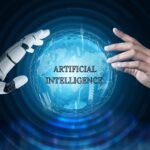Table of Contents
Introduction
Renewable energy is no longer just an option; it’s a necessity for a sustainable future. With the world facing the dual challenges of climate change and dwindling fossil fuel resources, the shift to clean, renewable energy sources is critical. But as we transition, we encounter complex challenges that demand innovative solutions. That’s where Artificial Intelligence (AI) steps in. AI has emerged as a powerful tool to enhance the efficiency, reliability, and scalability of renewable energy systems. In this article, we’ll explore 12 inspiring breakthroughs where AI is making a significant impact in the renewable energy sector.
Revolutionizing Solar Power with AI
AI-Optimized Solar Panel Placement:
One of the most crucial factors in maximizing solar energy output is the precise placement of solar panels. AI has revolutionized this process by analyzing vast amounts of data—such as weather patterns, topography, and sunlight exposure—to determine the optimal locations for solar panels. This not only increases energy production but also reduces costs by minimizing wasted space and ensuring panels are placed where they can capture the most sunlight.
For example, in a project in India, AI algorithms were used to analyze satellite images and weather data to identify the best locations for solar farms. This led to a significant increase in energy output compared to traditional methods, showcasing the potential of AI in enhancing solar energy efficiency.
Predictive Maintenance for Solar Farms:
Solar panels, like all equipment, are prone to wear and tear. Traditionally, maintenance has been reactive, with repairs made only after a failure occurs. However, AI is changing the game with predictive maintenance. By analyzing data from sensors on solar panels, AI can predict when a panel is likely to fail and schedule maintenance before the failure happens. This not only prevents downtime but also extends the lifespan of the equipment.
In a project by the U.S. Department of Energy, AI-driven predictive maintenance reduced operational costs by 20% and increased the overall efficiency of solar farms, proving that AI can make solar energy more reliable and cost-effective.
Wind Energy Enhancement through AI
AI-Driven Wind Farm Design:
The design and layout of wind farms are critical to maximizing energy production. AI has enabled more efficient wind farm designs by simulating various configurations and selecting the one that optimizes energy output while minimizing costs. AI can analyze wind patterns, topography, and even the impact on local wildlife to create the most effective wind farm layouts.
For instance, a wind farm in Denmark used AI to redesign its turbine placement, resulting in a 15% increase in energy production. This breakthrough illustrates how AI can optimize wind energy systems, making them more efficient and sustainable.
Real-Time Wind Speed and Direction Forecasting:
Accurate forecasting of wind speed and direction is essential for the optimal operation of wind turbines. AI has greatly improved the accuracy of these forecasts by analyzing large datasets, including historical weather patterns and real-time sensor data. This allows wind farms to adjust turbine settings in real time, maximizing energy production and protecting the turbines from damage.
In the Netherlands, an AI-powered wind forecasting system improved energy production by 10% while reducing wear and tear on turbines. This not only enhances efficiency but also extends the operational life of wind farms, making wind energy a more viable and sustainable option.
AI in Hydropower Management
Smart Water Flow Management:
Hydropower is one of the oldest forms of renewable energy, but it is not without its challenges. Managing water flow to optimize energy production while minimizing environmental impact is a complex task. AI has stepped in to address this challenge by providing real-time data analysis and predictive modeling. This allows for more precise control of water flow, ensuring maximum energy production with minimal environmental disruption.
For example, in a Canadian hydropower project, AI was used to optimize water flow, resulting in a 12% increase in energy production and a significant reduction in the impact on local ecosystems. This demonstrates how AI can modernize even the most traditional forms of renewable energy.
Predicting Environmental Impact:
One concern with hydropower is its potential impact on local ecosystems. AI is helping to mitigate these effects by predicting the environmental impact of hydropower projects before they are implemented. By analyzing data on local wildlife, water quality, and other environmental factors, AI can help engineers design projects that minimize harm to the environment.
A hydropower project in Brazil used AI to predict and mitigate its impact on the local river ecosystem, leading to a more sustainable project that balanced energy production with environmental preservation.
AI-Powered Energy Storage Solutions
Optimizing Battery Storage Systems:
Energy storage is a critical component of any renewable energy system, allowing energy to be stored for use when production is low. AI has made significant advancements in optimizing battery storage systems, improving their efficiency, and extending their lifespan. By analyzing usage patterns and predicting future demand, AI can more effectively manage battery charge and discharge cycles.
In Australia, an AI-powered battery management system increased the efficiency of energy storage by 25%, demonstrating the potential of AI to enhance the reliability and sustainability of renewable energy systems.
Forecasting Energy Demand and Supply:
One of the biggest challenges in renewable energy is balancing supply and demand. AI is addressing this challenge by accurately forecasting energy demand and matching it with available supply. By analyzing data from weather forecasts, historical usage patterns, and real-time grid conditions, AI can predict when and where energy will be needed and adjust supply accordingly.
In Germany, an AI-driven energy management system improved the balance between supply and demand, reducing the need for fossil fuel backup power and increasing the reliability of the renewable energy grid.
Enhancing Biomass Energy with AI
AI in Biomass Feedstock Optimization:
Biomass energy relies on organic materials, and the efficiency of this process depends heavily on the quality of the feedstock. AI has been used to optimize the selection and processing of biomass feedstock, ensuring that the most efficient and sustainable materials are used. This not only improves energy production but also reduces waste and emissions.
For example, an AI-powered biomass plant in Sweden optimized its feedstock selection, resulting in a 20% increase in energy output and a significant reduction in carbon emissions. This showcases the potential of AI to make biomass energy cleaner and more efficient.
Emission Reduction through AI:
One of the challenges of biomass energy is controlling emissions. AI is helping to address this by optimizing combustion processes and emissions control systems. By analyzing data from sensors and adjusting parameters in real time, AI can reduce harmful emissions, making biomass a cleaner energy source.
A project in Finland used AI to reduce emissions from a biomass plant by 15%, demonstrating that AI can make biomass energy a more sustainable option.
Integrating AI in Smart Grids
AI for Grid Stability and Reliability:
As more renewable energy sources are integrated into the grid, maintaining stability and reliability becomes more challenging. AI is playing a crucial role in managing these complex systems. By analyzing real-time data from across the grid, AI can predict and respond to fluctuations in supply and demand, ensuring that the grid remains stable even as renewable inputs vary.
In California, an AI-enhanced smart grid improved reliability by 30% during periods of high renewable energy input, proving that AI is essential for the future of smart grids.
Demand Response and Energy Efficiency:
AI is also being used to manage demand response programs, which incentivize consumers to reduce their energy use during peak times. By analyzing consumption patterns and predicting peak demand periods, AI can automate these programs, ensuring that they are both effective and efficient.
A project in Japan used AI to optimize demand response, resulting in a 15% reduction in peak energy demand and significant cost savings for consumers and utilities alike.
AI in Geothermal Energy Exploration
Identifying Optimal Drilling Sites:
Geothermal energy is a reliable and sustainable source of power, but finding the best drilling sites can be challenging. AI is transforming geothermal exploration by analyzing geological data to identify the most promising sites. This not only increases the success rate of drilling projects but also reduces costs and environmental impact.
In Iceland, AI was used to identify optimal drilling sites for a new geothermal project, resulting in a 30% increase in energy production compared to traditional methods. This breakthrough highlights the potential of AI to expand the use of geothermal energy.
Monitoring and Maintaining Geothermal Plants:
Once a geothermal plant is operational, AI can be used to monitor and maintain the facility. By analyzing data from sensors, AI can predict equipment failures and optimize maintenance schedules, reducing downtime and increasing efficiency.
A geothermal plant in Kenya used AI to reduce maintenance costs by 20% while increasing energy production, showing that AI can enhance the reliability and sustainability of geothermal energy.
AI-Driven Wave and Tidal Energy Innovations
Predictive Modelling for Ocean Energy:
Wave and tidal energy are emerging sources of renewable power, but they present unique challenges due to the ocean’s unpredictable nature. AI is helping to overcome these challenges by providing predictive modeling that forecasts ocean conditions and optimizes energy capture.
In Scotland, an AI-powered wave energy project improved energy production by 25% by accurately predicting wave patterns and adjusting the system accordingly. This demonstrates the potential of AI to unlock the ocean’s power for renewable energy.
Enhancing Device Design and Efficiency:
AI is also being used to improve the design and efficiency of wave and tidal energy devices. By simulating different designs and analyzing their performance, AI can identify the most efficient configurations, leading to higher energy output and lower costs.
A tidal energy project in Canada used AI to redesign its energy converters, resulting in a 20% increase in efficiency. This breakthrough shows how AI can drive innovation in emerging renewable energy technologies.
AI and Renewable Energy Policy Making
Data-Driven Decision Making:
Policymakers play a crucial role in the transition to renewable energy, and AI is helping them make more informed decisions. By analyzing data from energy systems, AI can provide insights that guide policy decisions, ensuring that they are based on accurate and up-to-date information.
For example, in the European Union, AI is being used to analyze the impact of different renewable energy policies, helping policymakers choose the most effective strategies for reducing carbon emissions and increasing renewable energy adoption.
Predicting Future Energy Trends:
AI is also being used to predict future energy trends, allowing policymakers and energy companies to plan for the long term. By analyzing data from a wide range of sources, including economic indicators, technological advancements, and environmental factors, AI can forecast the future of energy and help guide investment and policy decisions.
In the United States, AI-driven forecasts have been used to shape long-term energy strategies, ensuring that the country remains on track to meet its renewable energy goals.
AI-Enabled Carbon Capture and Storage
Optimizing Carbon Capture Processes:
Carbon capture and storage (CCS) is a critical technology for reducing greenhouse gas emissions, and AI is playing a key role in making it more efficient. By optimizing the capture process, AI can reduce the energy required and increase the amount of carbon that is captured and stored.
A CCS project in Norway used AI to optimize its processes, resulting in a 20% increase in carbon capture efficiency. This breakthrough demonstrates the potential of AI to make CCS a more viable tool in the fight against climate change.
Predicting and Reducing Carbon Emissions:
AI is also being used to predict and reduce carbon emissions in real time. By analyzing data from industrial processes, AI can identify areas where emissions can be reduced and implement changes automatically, leading to significant reductions in greenhouse gas output.
In China, an AI-driven system was able to reduce carbon emissions from a coal plant by 15%, showing that AI can play a crucial role in mitigating the environmental impact of traditional energy sources.
AI in Renewable Energy Financing
Risk Assessment and Investment Optimization:
Investing in renewable energy can be risky, but AI is helping to reduce that risk by providing more accurate assessments and optimizing investment strategies. By analyzing data from past projects and current market conditions, AI can predict the likelihood of success and guide investors toward the most promising opportunities.
In the UK, an AI-driven investment platform has helped direct billions of pounds into renewable energy projects, reducing risk and increasing returns for investors.
Crowdfunding and Community Investments:
AI is also enabling new forms of financing for renewable energy projects, such as crowdfunding and community investments. By analyzing data on potential investors and optimizing campaigns, AI can help raise funds more effectively and democratize access to renewable energy investments.
A solar energy project in the United States used AI to optimize its crowdfunding campaign, raising millions of dollars from small investors and enabling the project to move forward. This breakthrough shows how AI can make renewable energy more accessible and inclusive.
Conclusion
AI is revolutionizing the renewable energy sector, driving innovations that are making clean energy more efficient, reliable, and accessible. From optimizing solar and wind power to enhancing energy storage and reducing emissions, AI is playing a crucial role in the transition to a sustainable energy future. As these technologies continue to evolve, the potential for AI to further accelerate the adoption of renewable energy is immense. The future of energy is bright, and AI is lighting the way.









